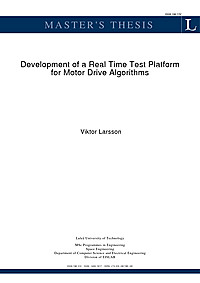
Development of a real time test platform for motor drive algorithms
In this thesis a real time test platform for a permanent magnet synchronous motor is developed. The implemented algorithm is Field Oriented Control (FOC) and it is implemented on a Texas Instruments TMS320F2808 Digital Signal Processor (DSP). The platform is developed in a rapid prototyping approach using Matlab/Simulink and the Real Time Workshop (RTW) packages.With this software the control algorithm and its interface to different DSP modules, such as A/D converter and PWM module, is constructed as a Simulink block scheme. The blocks used come from ordinary Simulink libraries and libraries provided by the RTW packages. From the Simulink block scheme Matlab can auto generate embedded C code adapted for different embedded targets, in this case the 2808 DSP.The developed real time test platform is also a Simulink model, though different from the algorithm model. When the start simulation command is given in the platform model a Graphical User Interface is loaded which lets the user specify motor parameters and certain algorithm parameters. Once the parameters are chosen RTW generates code from the algorithm model, loads it into the DSP and runs the generated program. From the platform model it is possible to set the reference speed of the motor in real time and monitor/log motor parameters such as actual speed and stator currents.
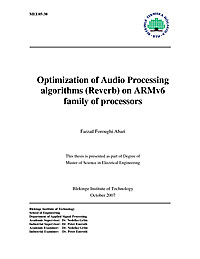
Optimization of Audio Processing algorithms (Reverb) on ARMv6 family of processors
Audio processing algorithms are increasingly used in cell phones and today’s customers are placing more demands on cell phones. Feature phones, once the advent of mobile phone technology, nowadays do more than just providing the user with MP3 play back or advanced audio effects. These features have become an integral part of medium as well as low-end phones. On the other hand, there is also an endeavor to include as improved quality as possible into products to compete in market and satisfy users’ needs. Tackling the above requirements has been partly satisfied by the advance in hardware design and manufacturing technology. However, as new hardware emerges into market the need for competence to write efficient software and exploit the new features thoroughly and effectively arises. Even though compilers are also keeping up with the new tide space for hand optimized code still exist. Wrapped in the above goal, an effort was made in this thesis to partly cover the competence requirement at Multimedia Section (part of Ericsson Mobile Platforms) to develope optimized code for new processors. Forging persistently ahead with new products, EMP has always incorporated the latest technology into its products among which ARMv6 family of processors has the main central processing role in a number of upcoming products. To fully exploit latest features provided by ARMv6, it was required to probe its new instruction set among which new media processing instructions are of outmost importance. In order to execute DSP-intensive algorithms (e.g. Audio Processing algorithms) efficiently, the implementation should be done in low-level code applying available instruction set. Meanwhile, ARMv6 comes with a number of new features in comparison with its predecessors. SIMD (Single Instruction Multiple Data) and VFP (Vector Floating Point) are the most prominent media processing improvements in ARMv6. Aligned with thesis goals and guidelines, Reverb algorithm which is among one of the most complicated audio features on a hand-held devices was probed. Consequently, its kernel parts were identified and implementation was done both in fixed-point and floating-point using the available resources on hardware. Besides execution time and amount of code memory for each part were measured and provided in tables and charts for comparison purposes. Conclusions were finally drawn based on developed code’s efficiency over ARM compiler’s as well as existing code already developed and tailored to ARMv5 processors. The main criteria for optimization was the execution time. Moreover, quantization effect due to limited precision fixed-point arithmetic was formulated and its effect on quality was elaborated. The outcomes, clearly indicate that hand optimization of kernel parts are superior to Compiler optimized alternative both from the point of code memory as well as execution time. The results also confirmed the presumption that hand optimized code using new instruction set can improve efficiency by an average 25%-50% depending on the algorithm structure and its interaction with other parts of audio effect. Despite its many draw backs, fixed-point implementation remains yet to be the dominant implementation for majority of DSP algorithms on low-power devices.
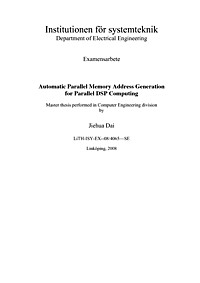
Automatic Parallel Memory Address Generation for Parallel DSP Computing
The concept of Parallel Vector (scratch pad) Memories (PVM) was introduced as one solution for Parallel Computing in DSP, which can provides parallel memory addressing efficiently with minimum latency. The parallel programming more efficient by using the parallel addressing generator for parallel vector memory (PVM) proposed in this thesis. However, without hiding complexities by cache, the cost of programming is high. To minimize the programming cost, automatic parallel memory address generation is needed to hide the complexities of memory access. This thesis investigates methods for implementing conflict-free vector addressing algorithms on a parallel hardware structure. In particular, match vector addressing requirements extracted from the behaviour model to a prepared parallel memory addressing template, in order to supply data in parallel from the main memory to the on-chip vector memory. According to the template and usage of the main and on-chip parallel vector memory, models for data pre-allocation and permutation in scratch pad memories of ASIP can be decided and configured. By exposing the parallel memory access of source code, the memory access flow graph (MFG) will be generated. Then MFG will be used combined with hardware information to match templates in the template library. When it is matched with one template, suited permutation equation will be gained, and the permutation table that include target addresses for data pre-allocation and permutation is created. Thus it is possible to automatically generate memory address for parallel memory accesses. A tool for achieving the goal mentioned above is created, Permutator, which is implemented in C++ combined with XML. Memory access coding template is selected, as a result that permutation formulas are specified. And then PVM address table could be generated to make the data pre-allocation, so that efficient parallel memory access is possible. The result shows that the memory access complexities is hiden by using Permutator, so that the programming cost is reduced.It works well in the context that each algorithm with its related hardware information is corresponding to a template case, so that extra memory cost is eliminated.
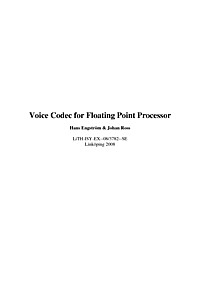
Voice Codec for Floating Point Processor
As part of an ongoing project at the department of electrical engineering, ISY, at Linköping University, a voice decoder using floating point formats has been the focus of this master thesis. Previous work has been done developing an mp3-decoder using the floating point formats. All is expected to be implemented on a single DSP.The ever present desire to make things smaller, more efficient and less power consuming are the main reasons for this master thesis regarding the use of a floating point format instead of the traditional integer format in a GSM codec. The idea with the low precision floating point format is to be able to reduce the size of the memory. This in turn reduces the size of the total chip area needed and also decreases the power consumption.One main question is if this can be done with the floating point format without losing too much sound quality of the speech. When using the integer format, one can represent every value in the range depending on how many bits are being used. When using a floating point format you can represent larger values using fewer bits compared to the integer format but you lose representation of some values and have to round the values off.From the tests that have been made with the decoder during this thesis, it has been found that the audible difference between the two formats is very small and can hardly be heard, if at all. The rounding seems to have very little effect on the quality of the sound and the implementation of the codec has succeeded in reproducing similar sound quality to the GSM standard decoder.
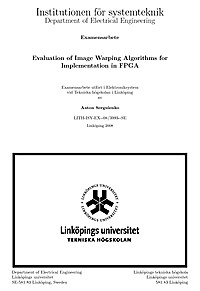
Evaluation of Image Warping Algorithms for Implementation in FPGA
The target of this master thesis is to evaluate the Image Warping technique and propose a possible design for an implementation in FPGA. The Image Warping is widely used in the image processing for image correction and rectification. A DSP is a usual choice for implantation of the image processing algorithms, but to decrease a cost of the target system it was proposed to use an FPGA for implementation. In this work a different Image Warping methods was evaluated in terms of performance, produced image quality, complexity and design size. Also, considering that it is not only Image Warping algorithm which will be implemented on the target system, it was important to estimate a possible memory bandwidth used by the proposed design. The evaluation was done by implemented a C-model of the proposed design with a finite datapath to simulate hardware implementation as close as possible.

DSP Platform Benchmarking
Benchmarking of DSP kernel algorithms was conducted in the thesis on a DSP processor for teaching in the course TESA26 in the department of Electrical Engineering. It includes benchmarking on cycle count and memory usage. The goal of the thesis is to evaluate the quality of a single MAC DSP instruction set and provide suggestions for further improvement in instruction set architecture accordingly. The scope of the thesis is limited to benchmark the processor only based on assembly coding. The quality check of compiler is not included. The method of the benchmarking was proposed by BDTI, Berkeley Design Technology Incorporations, which is the general methodology used in world wide DSP industry. Proposals on assembly instruction set improvements include the enhancement of FFT and DCT. The cycle cost of the new FFT benchmark based on the proposal was XX% lower, showing that the proposal was right and qualified. Results also show that the proposal promotes the cycle cost score for matrix computing, especially matrix multiplication. The benchmark results were compared with general scores of single MAC DSP processors offered by BDTI.
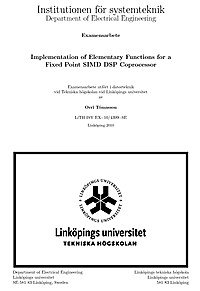
Implementation of Elementary Functions for a Fixed Point SIMD DSP Coprocessor
This thesis is about implementing the functions for reciprocal, square root, inverse square root and logarithms on a DSP platform. A multi-core DSP platform that consists of one master processor core and several SIMD coprocessor cores is currently being designed by a team at the Computer Engineering Department of Linköping University. The SIMD coprocessors’ arithmetic logic unit (ALU) has 16 multipliers to support vector multiplication instructions. By efficiently using the 16 multipliers, it is possible to evaluate polynomials very fast. The ALU does not have (hardware) support for floating point arithmetic, so the challenge is to get good precision by using fixed point arithmetic. Precise and fast solutions to implement the mathematical functions are found by converting the fixed point input to a soft floating point format before polynomial approximation, choosing a polynomial based on an error analysis of the polynomial approximation, and using Newton-Raphson or Goldschmidt iterations to improve the precision of the polynomial approximations. Finally, suggestions are made of changes and additions to the instruction set architecture, in order to make the implementations faster, by efficiently using the currently existing hardware.
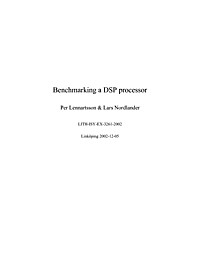
Benchmarking a DSP processor
This Master thesis describes the benchmarking of a DSP processor. Benchmarking means measuring the performance in some way. In this report, we have focused on the number of instruction cycles needed to execute certain algorithms. The algorithms we have used in the benchmark are all very common in signal processing today. The results we have reached in this thesis have been compared to benchmarks for other processors, performed by Berkeley Design Technology, Inc. The algorithms were programmed in assembly code and then executed on the instruction set simulator. After that, we proposed changes to the instruction set, with the aim to reduce the execution time for the algorithms. The results from the benchmark show that our processor is at the same level as the ones tested by BDTI. Probably would a more experienced programmer be able to reduce the cycle count even more, especially for some of the more complex benchmarks.
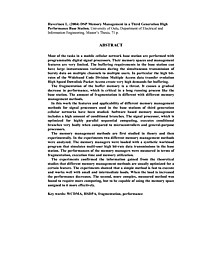
DSP Memory Management in a Third Generation High Performance Base Station
Most of the tasks in a mobile cellular network base station are performed with programmable digital signal processors. Their memory spaces and management features are very limited. The buffering requirements in the base station can have large instantaneous variations during the simultaneous transmission of burst' data on multiple channels to multiple users. In particular the high bit-rates of the Wideband Code Division Multiple Access data transfer evolution High Speed Downlink Packet Access create very high demands for buffering. The fragmentation of the buffer memory is a threat. It causes a gradual decrease in performance, which is critical in a long running process like the base station. The amount of fragmentation is different with different memory management methods. In this work the features and applicability of different memory management methods for signal processors used in the base stations of third generation cellular networks have been studied. Software based memory management includes a high amount of conditional branches. The signal processor, which is optimized for highly parallel sequential computing, executes conditional branches very badly when compared to microcontrollers and general-purpose processors. The memory management methods are first studied in theory and then experimentally. In the experiments two different memory management methods were analyzed. The memory managers were loaded with a synthetic workload program that simulates multi-user high bit-rate data transmissions in the base station. The performances of the memory managers were measured in terms of fragmentation, execution time and memory utilization. The experiments confirmed the information gained from the theoretical studies that different memory management methods are usually optimized for a certain feature. The experiments showed that a simple method is fast to execute and works well with small and intermediate loads. When the load is increased the performance decreases. The second, more complex, measured method was found to require more computing, but to be capable of using the memory space assigned to it more effectively.
Signal Processing Requirements for WiMAX (802.16e) Base Station
802.16e provides specifications for non line of sight, mobile wireless communications in the frequency range of 2-6 GHz. It is well implemented by using OFDMA as its physical layer scheme. The OFDM symbol time (sT) is to be selected depending on the channel conditions, available bandwidth and, simulations provide a means of selecting right values of sTin different channel conditions. Additionally it has been shown that certain values of sT outperform others in all conditions, thus invalidating their use. Moreover, a solution proposed by INTEL is also analyzed. One of the major requirements of OFDM is high synchronization. Detecting the timing offset of a new mobile user, entering the network, which is not time aligned using cross-correlation and ‘auto-correlation’ in time domain and cross-correlation in frequency domain at the base station has been simulated. Results point that the processing load can be significantly reduced by using frequency domain correlation of the received data or by using ‘auto-correlation’ followed by cross-correlation on localized data. The use of adaptive antenna system in 802.16e improves the system performance, where beamforming is implemented in the direction of desired user. Capon’s method and MUSIC method have been simulated to compute the direction of arrival for OFDMA uplink. A new user, while in the ranging process, transmits data with unknown time offset and unknown direction. The thesis describes the procedure to find the two unknown one after another.
A Prototype Laboratory Environment for Digital Signal Processing Using Simulink and a Texas Instrument DSP Device
Normally, when a model is designed from building blocks in Simulink, the simulation is performed within the Simulink environment. A test of the design in a real-time environment requires that source code is generated, compiled and downloaded to the target hardware. As a first attempt to bridge this software gap, this thesis describes and evaluates a prototype laboratory environment, which directly links Simulink to a Texas Instrument DSP device. The prototype system converts graphical models and makes available various real-time signal processing algorithms, such as adders, delays, FFTs, IIR filters and multipliers. Future work is to consider modification of the prototype to allow for feedback in the graphical models and to find an efficient way of handling signal processing algorithms where variable buffer lengths are required.
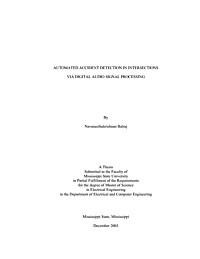
Automated Accident Detection in Intersections Via Digital Audio Signal Processing
The aim of this thesis is to design a system for automated accident detection in intersections. The input to the system is a three-second audio signal. The system can be operated in two modes: two-class and multi-class. The output of the two-class system is a label of “crash” or “non-crash”. In the multi-class system, the output is the label of “crash” or various non-crash incidents including “pile drive”, “brake”, and “normal-traffic” sounds. The system designed has three main steps in processing the input audio signal. They are: feature extraction, feature optimization and classification. Five different methods of feature extraction are investigated and compared; they are based on the discrete wavelet transform, fast Fourier transform, discrete cosine transform, real cepstrum transform and Mel frequency cepstral transform. Linear discriminant analysis (LDA) is used to optimize the features obtained in the feature extraction stage by linearly combining the features using different weights. Three types of statistical classifiers are investigated and compared: the nearest neighbor, nearest mean, and maximum likelihood methods. Data collected from Jackson, MS and Starkville, MS and the crash signals obtained from Texas Transportation Institute crash test facility are used to train and test the designed system. The results showed that the wavelet based feature extraction method with LDA and maximum likelihood classifier is the optimum design. This wavelet-based system is computationally inexpensive compared to other methods. The system produced classification accuracies of 95% to 100% when the input signal has a signal-to-noise-ratio of at least 0 decibels. These results show that the system is capable of effectively classifying “crash” or “non-crash” on a given input audio signal.
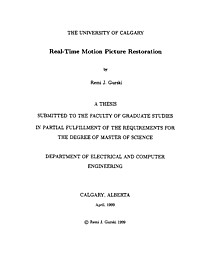
Real-time Motion Picture Restoration
Through age or misuse, motion picture films can develop damage in the form of dirt or scratches which detract from the quality of the film. Removal of these artifacts is a worthwhile process as it makes the films more visually attractive and extends the life of the material. In this thesis, various methods for detecting and concealing the effects of film damage are described. Appropriate algorithms are selected for implementation of a system, based on a TMS320C80 video processor, which can remove the effects of film defects using digital processing. The restoration process operates in real-time at video frame rates (30 frames per second). Details of the software implementation of this system are presented along with results from processing damaged film material. The effects of damage are significantly reduced after processing.
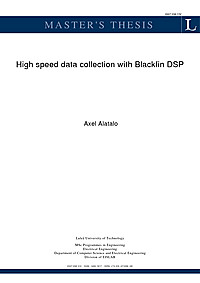
High speed data collection with Blackfin DSP
This report covers a master thesis in embedded systems, the goal of which was to investigate the high speed data collection capabilities with a Blackfin DSP. Basic theory about sampling and noise is covered briefly from a practical point of view. The theory is intended to be useful for those diving into a ADC datasheet for the first time. After an investigation of the delimiting factors, suitable components were selected and a prototype ADC PCB was designed from scratch. The goal is to design a general low noise data collecting unit compatible with the Blackfin DSP. Finally simple DSP software is designed to prove that DSP can handle such a high datastream.Testing the ADC card with the target Blackfin platform indicates thatthe analog parts indeed works. An analog bandwidth of over 10MHz ismeasured at a resolution exceeding 10 bits with respect to noise. The digital parts intended to interleave the two channels digital streams into one Blackfin unit did not work as intended. Only one channel is supported as of now. The report contains suggestions for future work in this area.

DSP Platform Benchmarking
Benchmarking of DSP kernel algorithms was conducted in the thesis on a DSP processor for teaching in the course TESA26 in the department of Electrical Engineering. It includes benchmarking on cycle count and memory usage. The goal of the thesis is to evaluate the quality of a single MAC DSP instruction set and provide suggestions for further improvement in instruction set architecture accordingly. The scope of the thesis is limited to benchmark the processor only based on assembly coding. The quality check of compiler is not included. The method of the benchmarking was proposed by BDTI, Berkeley Design Technology Incorporations, which is the general methodology used in world wide DSP industry. Proposals on assembly instruction set improvements include the enhancement of FFT and DCT. The cycle cost of the new FFT benchmark based on the proposal was XX% lower, showing that the proposal was right and qualified. Results also show that the proposal promotes the cycle cost score for matrix computing, especially matrix multiplication. The benchmark results were compared with general scores of single MAC DSP processors offered by BDTI.

DSP Memory Management in a Third Generation High Performance Base Station
Most of the tasks in a mobile cellular network base station are performed with programmable digital signal processors. Their memory spaces and management features are very limited. The buffering requirements in the base station can have large instantaneous variations during the simultaneous transmission of burst' data on multiple channels to multiple users. In particular the high bit-rates of the Wideband Code Division Multiple Access data transfer evolution High Speed Downlink Packet Access create very high demands for buffering. The fragmentation of the buffer memory is a threat. It causes a gradual decrease in performance, which is critical in a long running process like the base station. The amount of fragmentation is different with different memory management methods. In this work the features and applicability of different memory management methods for signal processors used in the base stations of third generation cellular networks have been studied. Software based memory management includes a high amount of conditional branches. The signal processor, which is optimized for highly parallel sequential computing, executes conditional branches very badly when compared to microcontrollers and general-purpose processors. The memory management methods are first studied in theory and then experimentally. In the experiments two different memory management methods were analyzed. The memory managers were loaded with a synthetic workload program that simulates multi-user high bit-rate data transmissions in the base station. The performances of the memory managers were measured in terms of fragmentation, execution time and memory utilization. The experiments confirmed the information gained from the theoretical studies that different memory management methods are usually optimized for a certain feature. The experiments showed that a simple method is fast to execute and works well with small and intermediate loads. When the load is increased the performance decreases. The second, more complex, measured method was found to require more computing, but to be capable of using the memory space assigned to it more effectively.
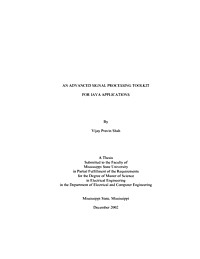
An Advanced Signal Processing Toolkit for Java applications
The aim of this study is to examine the capability, performance, and relevance of a signal processing toolkit in Java, a programming language for Web-based applications. Due to the simplicity, ease and application use of the toolkit and with the advanced Internet technologies such as Remote Method Invocation (RMI), a spectral estimation applet has been created in the Java environment. This toolkit also provides an interactive and visual approach in understanding the various theoretical concepts of spectral estimation and shows the need to create more application applets to better understand the various concepts of signal and image processing. This study also focuses on creating a Java toolkit for embedded systems, such as Personal Digital Assistants (PDAs), embedded Java board, and supporting integer precision, and utilizing COordinate Rotation DIgital Computer (CORDIC) algorithm, both aimed to provide good performance in resource-limited environments. The results show a feasibility and necessity of developing a standardized Application Programming Interface (API) for the fixed-point signal processing library.

Implementation of Elementary Functions for a Fixed Point SIMD DSP Coprocessor
This thesis is about implementing the functions for reciprocal, square root, inverse square root and logarithms on a DSP platform. A multi-core DSP platform that consists of one master processor core and several SIMD coprocessor cores is currently being designed by a team at the Computer Engineering Department of Linköping University. The SIMD coprocessors’ arithmetic logic unit (ALU) has 16 multipliers to support vector multiplication instructions. By efficiently using the 16 multipliers, it is possible to evaluate polynomials very fast. The ALU does not have (hardware) support for floating point arithmetic, so the challenge is to get good precision by using fixed point arithmetic. Precise and fast solutions to implement the mathematical functions are found by converting the fixed point input to a soft floating point format before polynomial approximation, choosing a polynomial based on an error analysis of the polynomial approximation, and using Newton-Raphson or Goldschmidt iterations to improve the precision of the polynomial approximations. Finally, suggestions are made of changes and additions to the instruction set architecture, in order to make the implementations faster, by efficiently using the currently existing hardware.
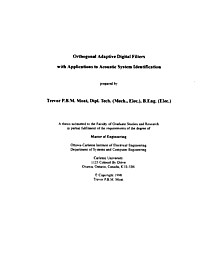
Orthogonal Adaptive Digital Filters with Applications to Acoustic System Identification
The Transform-Domain LMS Algorithm (Narayan, 1983) is studied in the context of an acoustic system identification problem. The power estimator in this two-stage digital filter is shown to affect the achievable rates and depths of convergence significantly. Preferred values for the two tracking parameters, $\beta$ and $\mu,$ are determined. Dynamic Step-size Initialization is proposed to improve early convergence by accelerating the rate at which true power measurements replace (arbitrary) initial values. Later, linear estimators are shown to be sub-optimal, particularly where the spectral distribution of the reference changes rapidly. A simple non-linear Peak Window Power Estimator which eliminates these problems is described. It will be shown to improve the tracking rates and misadjustment simultaneously. The benefits of these methods are demonstrated using FIR sequences representative of typical acoustic environments and using recordings from a commercial telephone set. The proposed structures surpass theexisting algorithms consistently under all circumstances tested.
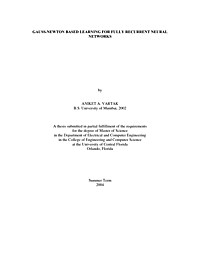
Gauss-Newton Based Learning for Fully Recurrent Neural Networks
The thesis discusses a novel off-line and on-line learning approach for Fully Recurrent Neural Networks (FRNNs). The most popular algorithm for training FRNNs, the Real Time Recurrent Learning (RTRL) algorithm, employs the gradient descent technique for finding the optimum weight vectors in the recurrent neural network. Within the framework of the research presented, a new off-line and on-line variation of RTRL is presented, that is based on the Gauss-Newton method. The method itself is an approximate Newton’s method tailored to the specific optimization problem, (non-linear least squares), which aims to speed up the process of FRNN training. The new approach stands as a robust and effective compromise between the original gradient-based RTRL (low computational complexity, slow convergence) and Newton-based variants of RTRL (high computational complexity, fast convergence). By gathering information over time in order to form Gauss-Newton search vectors, the new learning algorithm, GN-RTRL, is capable of converging faster to a better quality solution than the original algorithm. Experimental results reflect these qualities of GN-RTRL, as well as the fact that GN-RTRL may have in practice lower computational cost in comparison, again, to the original RTRL.


















